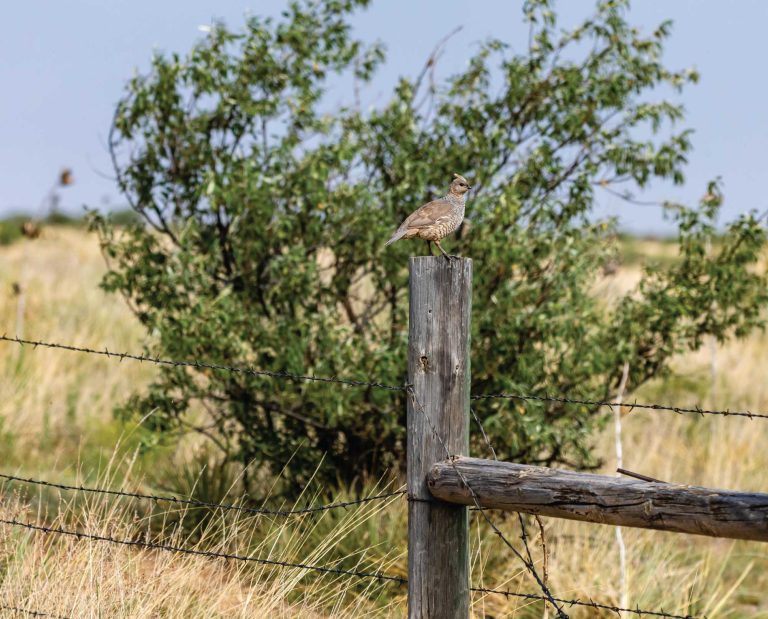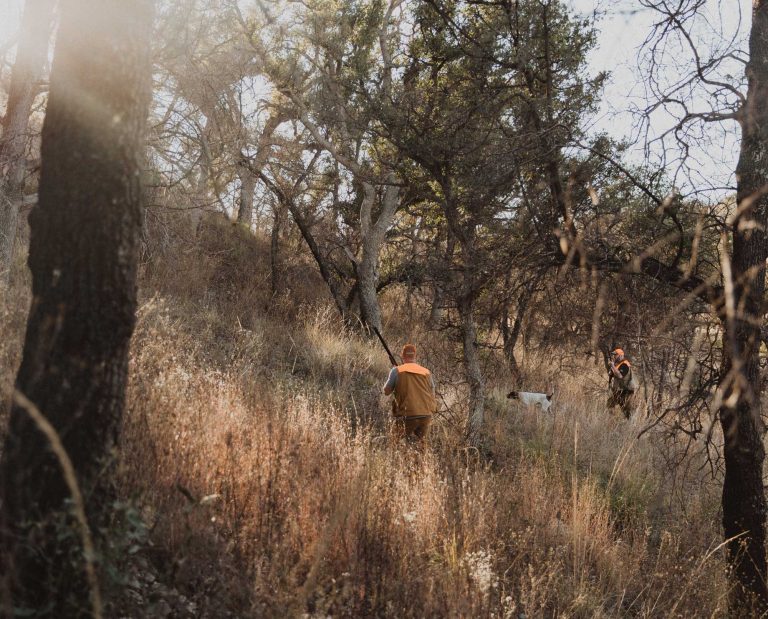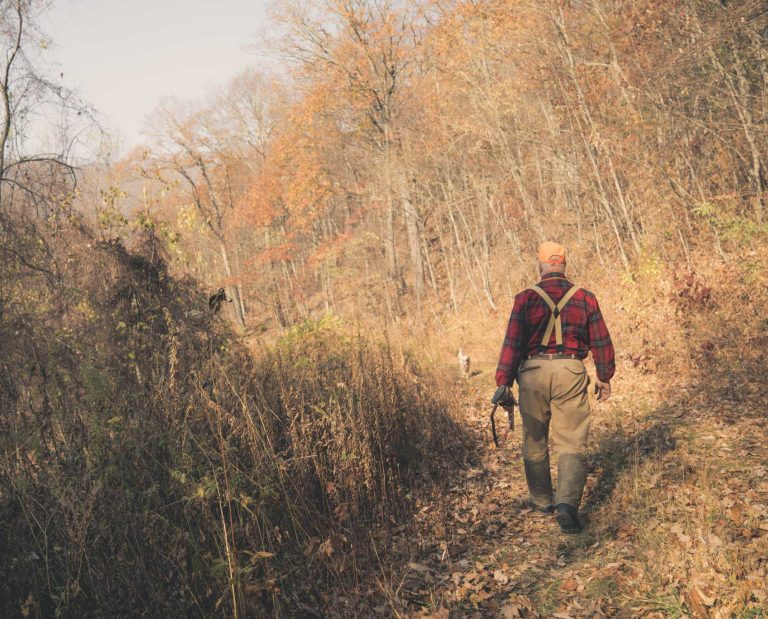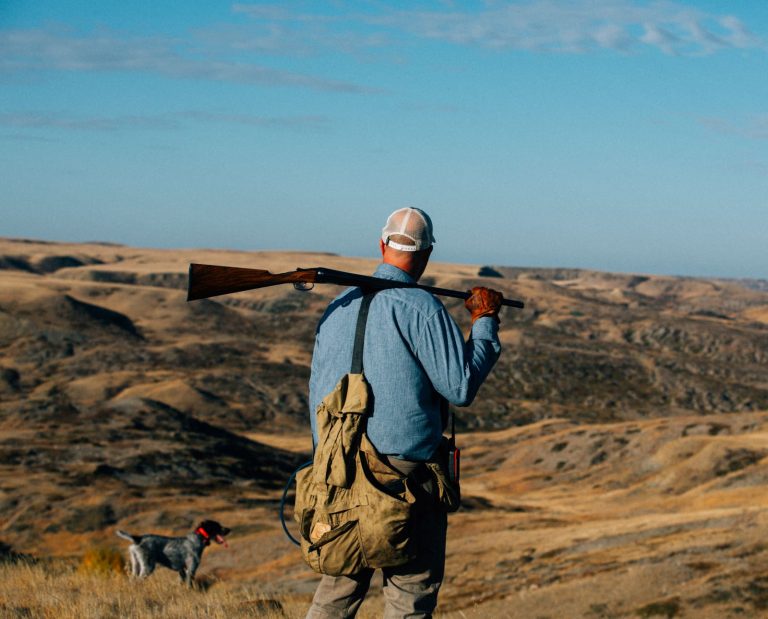Upland Hunting in Ontario

Ontario offers vast wilderness and ample upland hunting opportunities from various grouse species to pheasant
Ontario is over 415,000 square miles. That’s almost 150,000 square miles more than the state of Texas. It takes over 24 hours to make it across Ontario, and over 44 hours to make it all the way to the northern border. Best of all, 87 percent of the province’s vast wilderness is “Crown Land,” or Canadian public lands, which are open to both resident and non-resident hunters.
Since most of the province’s populations reside within a few hours of the US border, it leaves massive swaths of natural, largely untouched wilderness. Within those large borders, Ontario comprises a wide range of topography and unique environmental biomes, everything from rolling pastoral pastures in the south to dense boreal forests and even arctic tundra in the north. Each biome contains its own unique upland species and hunting opportunities.
Ontario isn’t just known for its trophy white tail, black bear and moose. It’s also an upland hunter’s paradise. Ontario is home to almost species a hunter could dream of, including grouse (sharp-tailed, ruffed, and spruce), woodcock, turkey, dove, huns, and the famous Pelee Island pheasant hunt.
Ontario Upland Bird Hunting Seasons
| Species* | Wildlife Management Unit | Season | Daily / Possession Limit |
| Ruffed Grouse | 1–4, 16–18, 24–27 | Sep 15 – Mar 31, 2024 | 5/15 (combined with Spruce Grouse) |
| 5–15, 19–23, 28–50, 53–67, 69B | Sep 15 – Dec 31, 2023 | 5/15 (combined with Spruce Grouse) | |
| 68, 73–76, 82–84 | Sep 25 – Dec 31, 2023 | 5/15 | |
| 69A, 70–72, 77–81, 85–95 | Sep 25 – Dec 31, 2023 | 2/6 | |
| Spruce Grouse | 1–4, 16–18, 24–27 | Sep 15 – Mar 31, 2024 | 5/15 (combined with Ruffed Grouse) |
| 5–15, 19–23, 28–50, 53–67, 69B | Sep 15 – Dec 31, 2023 | 5/15 (combined with Ruffed Grouse) | |
| Sharp-tailed Grouse | 1–4, 16–18, 24–27 | Sep 15 – Mar 31, 2024 | 5/15 |
| 5–15, 19–23, 28–35, 38–41 | Sep 15 – Dec 31, 2023 | 5/15 | |
| 36, 37, 42–50, 53–67, 69B | Sep 15 – Dec 31, 2023 | 2/6 | |
| Ptarmigan | 1–4, 16–18, 24–27 | Sep 15 – Mar 31, 2024 | 5/15 |
| Gray (Hungarian) Partridge | 36, 37, 42–50, 53–67, 69B | Sep 15 – Dec 31, 2023 | 5/15 |
| 68, 69A, 70–95 | Sep 25 – Dec 31, 2023 | 5/15 | |
| Ring-necked Pheasant | 1–4, 16–18, 24–27 | Sep 15 – Mar 31, 2024 | 10/10 |
| 5–15, 19–23, 28–50, 53–67, 69B | Sep 15 – Dec 31, 2023 | 10/10 | |
| 68, 69A, 70–94 | Sep 25 – Dec 31, 2023 | 3/10 | |
| 95 | Sep 25 – Feb 28, 2024 | 10/10 |
Ruffed & Spruce Grouse
Ruffed grouse, arguably the most prized and sought after game bird in the province, has an extensive range throughout Ontario. In fact, 80 percent of the world’s ruffed grouse population is found within Canada, and a large percentage of that is found in Ontario. Ontario hunters shoot over one million ruffed grouse each year, which is almost double that of the idyllic grouse state of Minnesota. Their wide range creates birds with unique personalities from timid and easy to flush in the southern regions, to curious and seemingly unafraid birds to the remote north.
Ruffed grouse are found in higher concentrations in areas where successional forestry is taking place. They’re also found where new aspen, birch, or other forests and vegetation are regrowing due to sustainable logging or forest fires. A popular species to hunt in Ontario, many hunters choose to either hunt by walking logging trails, using dogs, or road hunting. For more information on grouse hunting tactics, check out A Full Guide to Ruffed Grouse Hunting.
Spruce grouse, sometimes referred to as a Canadian grouse due to their extensive range within the country, are found in the central to northern ranges of Ontario. They prefer to live in dense, coniferous woods. Their native range tends to overlap with the ruffed grouse, which can provide for even more shooting opportunities in the many areas of the province. Spruce grouse are much more likely to be found perched on tree branches and moving from tree to tree than down on the ground like its cousin, the ruffed grouse. It goes by the nickname “fools hen” because they often choose to freeze and remain still instead of running or flushing.
Sharp-Tailed Grouse
Sharp-tailed grouse tend to be more elusive and harder to find in Ontario. This is mostly due to their preference for the remote northern regions of the province and Manitoulin Island to the west. Two subspecies of Sharp-tailed grouse live in Ontario: the northern sharp-tailed grouse and the prairie sharp-tailed grouse, the former being more prevalent. The sharptails in Ontario share some of their home range with ruffed and spruce grouse, adding another reason to travel to the northern regions of the province. Interestingly, northern Ontario populations of sharp-tailed grouse tend to live in swampy, brushy habitat in the boreal forests, and they are darker in appearance than birds found in more southern, open-prairie populations.
Ptarmigan (Rock and Willow)
Ontario is home to two species of ptarmigan: the rock and willow varieties. Finding one of the province’s most elusive game birds will require a long trip to the far northern end of Ontario near the James and Hudson Bay region. Willow ptarmigan are present in huntable populations, and the rock ptarmigan can only be found sporadically during the cold winter months. Not many roads or infrastructure exists where ptarmigan are found, so a fly-in trip may be required. Ptarmigan can sometimes be found farther south during cold winter seasons, but not in high enough concentrations to warrant pursuing.
Hungarian Partridge (Huns)
Huns were introduced to Ontario in the late 1800s and experienced a population peak in the 1960s. Unfortunately, Hun population levels have been in steady decline since then. Remaining populations are found in southwestern and eastern Ontario; northern populations have not been seen in years. Due to the fragility of the species in Ontario, the limited numbers that remain are often found on private land with highly protective owners. With high bag limits and challenging birds, it’s still an option for a dedicated hunter looking for a hard-to-hunt Ontario game bird.
Migratory Upland Game Bird Season
Managing migratory game birds’ hunting seasons is the responsibility of the federal government of Canada. Hunters are required to have a federal Migratory Game Bird Hunting Permit, Wildlife Habitat Conservation Stamp, and an Ontario small game license to hunt migratory game birds in any provinces or territories. Wildlife Habitat Conservation Stamps and Migratory Bird Permits are available for purchase at most post offices or online.
| Species* | Wildlife District | Season | Daily / Possession Limit |
| Woodcock | Hudson James Bay | Sep 15 – Dec 16, 2023 | 8/24 |
| North | Sep 15 – Dec 16, 2023 | 8/24 | |
| Central | Sep 15 – Dec 20, 2023 (WMU 60-67, 69B) | 8/24 | |
| South | Sep 25 – Dec 20, 2023 (WMU 68, 69A, 70-95) | 8/24 | |
| Dove | Hudson James Bay | No Season | |
| North | No Season | ||
| Central | Sep 1 – Nov 30, 2023 | 15/45 | |
| South | Sep 1 – Nov 30, 2023 | 15/45 |
Migratory Upland Game: Doves and American Woodcock
American Woodcock range throughout most of the central and southern parts of Ontario with both resident and migratory birds. Woodcock are often found on the edges of wet areas with new plant growth; places that ruffed grouse also enjoy. Despite being a migratory bird and requiring the related permits, non-toxic shot is not necessary when hunting woodcock in Ontario.
One of the newest huntable species in the province and one of the least targeted, the mourning dove is a migratory bird which requires all related permits in addition to non-toxic shot. Doves frequent agrarian areas found throughout the province, but are only huntable in the central and southern regions of Ontario.
Eastern Turkey Hunting in Ontario
The eastern turkey almost went extinct in Ontario and other parts of Canada, but the species was resurrected after efforts by the Ontario Federation of Anglers and Hunters through successful reintroduction programs. Twenty years later, eastern turkeys are now thriving and have huntable populations in many areas of the province. Due to the importance of the species for hunters, mandatory reporting of hunters’ harvest and observations are required after the season. Hunters may not use a shotgun not larger than 10 gauge or smaller than 20 gauge, and may only use shot sizes of 4, 5, 6 or 7. Unfortunately, regulations haven’t caught up to the improved ballistic capabilities of non-toxic materials like tungsten and TSS blends, so smaller shot sizes and calibers are not allowed. For turkey hunting tips, check out How to Run and Gun in Turkey Hunting.
| Eastern Turkey | Wildlife Management Unit | Season | Daily / Possession Limit |
| Spring Season | 36, 42, 45, 46–50, 53–65, 66A, 67–82, 83A, 84–95 | Apr 25 – May 31, 2023 | 1 bearded bird per day, 2 per season. |
| Fall Season (Bow and Shotgun) | 59, 60, 63, 64, 65, 66A, 67–70, 72–78, 80–82, 84-87, 89–94 | Oct 11 – Oct 23, 2023 | 1 Male or Female bird |
| Fall Season (Bow Only) | 59, 60, 63, 64, 65, 66A, 67–70, 72–78, 80–82, 84–87, 89–94 | Oct 1 – Oct 31, 2023 | 1 Male or Female bird |
Upland Bird Hunting Licensing Fees and Hunter Orange Requirments
To hunt small game, upland, and migratory birds in Ontario, hunters must be at least 16 years old, purchase and possess a small game license, have an Ontario Outdoor Card, and have proof of having a firearm license if you are hunting with a gun. All hunters must have passed the Ontario hunter education program or, if a non-resident, have completed a similar hunting program that’s recognized by the province. If you have a US hunter education card, a copy must be submitted to the Canada’s Fish and Wildlife Service prior to hunting. For upland species, only wild turkey hunting requires the hunter to purchase and use a game tag. In certain locations, additional licenses or permits may be required for turkey hunting.
All licensed hunters who are hunting during a concurrent gun season for either deer, elk, or moose are required to wear fluorescent orange while hunting. This regulation does not apply to people who are hunting migratory game birds, except woodcock. Orange clothing and an orange head cover must be worn. The orange garment includes either clothing or your pack, and must cover a minimum of 400 square inches above the waist and be visible from all sides. The hunter orange must be solid orange and cannot contain open mesh or camouflage orange.
| License | Resident | Non-Resident |
| Outdoors Card | $8.57 | $8.57 |
| Small Game | $22.76 | $121.52 |
| Migratory Bird Permit | $17 | $17 |
| Canadian Wildlife Conservation Stamp | $8.50 | $8.50 |
| Wild Turkey Tag (Fall or Spring) | $26.33 | $30.30 |
Firearms in Ontario, Canada
If you are hunting small game in an area where there is an open season for big game, you may not possess or use a rifle of greater caliber than a .22 caliber rim-fire rifle, shells loaded with ball, or shells loaded with shot larger than No. 2. This includes center-fire rifles, unless you have a valid license to hunt big game during the relevant open season. Outside of big game seasons, a small game hunter may not carry or use a rifle of greater caliber than a .275-caliber rifle, except a muzzle-loading gun.
Shotguns must be plugged so that they cannot hold more than a total of three shells in the chamber and magazine combined. Shot material for migratory birds like doves, ducks, and geese requires non-toxic shot. For all other species, including woodcock, lead shot may be used. For more information about bringing shotguns into Canada, check out How to Bring Shotguns to Canada.
Border Crossing With a Hunting Dog
If you are bringing a dog into Canada from the United States, your dog must appear healthy and you must also have a signed certificate from a veterinarian licensed in Canada or in the United States that indicates that the dog has been vaccinated against rabies within the last three years. For more information read Project Upland’s How to Bring a Dog Into Canada and Back to the States.
Game Bird Hunting Preserves
If you happen to visit the province out of hunting season, there is still hope! Ontario has several game hunting preserves that provide year-round hunting opportunities for northern bobwhite quail, Hungarian partridge, chukar, pheasant, and even wild turkey, for a fee. You are still required to have a valid Outdoors Card, hunter accreditation (e.g. license summary), and proof of firearm license if you are hunting with a gun.
Related Hunting Conservation Groups in Ontario
Ontario Federation of Anglers and Hunters (OFAH)
Canadian National Wild Turkey Federation (CNWTF)
North American Versatile Hunting Dogs Association (NAVHDA)
Ruffed Grouse / Woodcock Society of Canada (RGSC)
*Ontario honors the treaty rights of Indigenous peoples, therefore some of the information listed above may not be relevant to treaty hunters. Bird hunting season dates, game bird species available, and other information is subject to change. The article may not reflect this. Please visit Ontario.ca for the most up to date information on bird hunting in Ontario.








